| Rye %: | 100% |
| Stages: | Sponge, Scald, Scald-Sponge, Final Dough |
| Leaven: | Rye sour |
| Duration: | 19-25 hours |
| Prep Time: | 60 minutes |
| Yield: | one 3½ lb. (1.6 kg.) loaf |
There are many versions of Borodinsky Rye: this one first appeared in the 1935 edition of Tekhnologiya Khlebopyekarnogo Proyzvodstva (Bakery Production Technology) by the legendary Russian process engineer Lev Auerman. Unlike most Borodinsky variations, which contain wheat flour, this one is made of 100% rye. In addition, where many of the other variations have flavor profiles that feature a combination of both sweet and sour, in this one, sweet dominates, thanks to both the long scald and floral accents of scalded caraway or anise.
When I first baked this recipe, I was somewhat surprised by the stiffness of the dough (and subsequent density of the crumb), but forged ahead anyway, re-baking the bread some months later so that I could post it here on The Rye Baker.
As is my practice, I also posted links to the blog on Facebook, Twitter, Instagram and my favorite bread baking site, The Fresh Loaf. It was on TFL that Mike Zhuravel, whose knowledge of and experience with Russian breads is encyclopedic, and whose Russian-language blog, O Khlebye (On Bread) is my go-to source for all breads Russian, contributed some incredibly helpful feedback.
Specifically, he wrote:
Your dough was far too dry– you can see that from the telltale vertical crack – for several reasons. While the recipe you are ostensibly referring to indeed specifies 65-67% hydration, it was written for 50/50 mixture of whole and medium rye (in my own bake 66% was too dry for 50/50 mixture). Second reason – the recipe was written for a hearth bread, which tolerates very narrow hydration range. Pan breads are much more manageable and in Russian tradition are typically done at higher hydration, that is for the same recipe you will be given two hydrations, one for hearth and another, usually ~3-4% higher, for pan version. Third, it is my observation that in more than one recipe of that period hydrations are sometimes just off, and need to be adjusted, for the whole rye breads – always up.
Properly scalded and fermented caraway acquires a particular fruity flavor with no harshness raw seed is known for. Interestingly enough anise, also an option here, behaves the same and end result is very similar. This flavor is one of the keys to this bread; covering it up by throwing caraway on top is sacrilege, in my opinion.
I found Mike’s comments incredibly valuable and incorporated them into this revised recipe. First, I adjusted the fermentation and proofing times to reflect the fact that, as he noted:
“There’s every reason to believe that the original recipe describes fully manual process, and contemporary sources consistently talk about 500 kilo batches and mixing times of at least 30 minutes and up to an hour. Now factor in dividing and shaping, and your 30 minute bulk fermentation can easily turn into an hour, if not more. Same with proof, the recipe may mention 15-20 minute proof, but it is also very specific about what the dough is supposed to look like: ‘with a smooth surface covered with small holes, as if pricked with a pin’.”
I also followed his suggestions and substituted medium rye flour for the whole rye flour in both the sponge and the scald; increased the hydration to nearly 80%, which is more in line with other Borodinsky formulas I’ve seen; scaled down the quantities to fit the loaf pan; eliminated the yeast and the caraway topping (adding anise as an alternative ingredient to the scald); and finally, moderated the baking temperature.
This higher-hydration loaf has a close, cake-like crumb and a flavor profile in which a floral sweetness predominates. The astringency of the caraway, while clearly present, is muted, lending a delicate bite to the chew. As Russian rye breads go, this one is in a class by itself. I like it with flavors that accentuate and contrast its chewy sweetness — tangy soft cheeses like a young chevre or mascarpone, or a light coating of butter and a slab of smoked meat or fish.
Sponge (Day 1 Evening):
| Ingredient | Grams | Ounces | Baker’s Percentage |
| Medium rye flour |
60 |
2.10 |
100% |
| Warm (110°F/43°C) water |
60 |
2.10 |
100% |
| Rye sour culture |
9 |
0.30 |
15% |
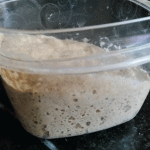 Combine the sponge ingredients, cover and ferment at room temperature (70°F/21°C) overnight, 12-16 hours. The sponge will be very bubbly, have a strong sour smell and will have begun to fall back on itself.
Combine the sponge ingredients, cover and ferment at room temperature (70°F/21°C) overnight, 12-16 hours. The sponge will be very bubbly, have a strong sour smell and will have begun to fall back on itself.
Scald (Day 1 Evening):
| Ingredient |
Grams |
Ounces |
Baker’s |
| Medium rye flour |
255 |
9.00 |
100% |
| Boiling water |
740 |
26.10 |
290% |
| Red rye malt |
51 |
1.80 |
20% |
| Caraway or anise seed, toasted and ground |
4 |
0.15 |
2% |
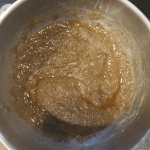 Toast the malted rye in a frying pan over medium heat, moving it constantly, until it becomes aromatic and turns a deep rose pink, 4-5 minutes. Let cool and use a spice grinder or mortar and pestle to grind the it to a fine powder. In the mixer bowl, combine the malt with the other scald ingredients and mix until smooth – it will look like chocolate pudding and have the consistency of a thick porridge.Cover and let stand at room temperature overnight, 12-16 hours. (For more information on scalds, see my post On Scalds and Scalding).
Toast the malted rye in a frying pan over medium heat, moving it constantly, until it becomes aromatic and turns a deep rose pink, 4-5 minutes. Let cool and use a spice grinder or mortar and pestle to grind the it to a fine powder. In the mixer bowl, combine the malt with the other scald ingredients and mix until smooth – it will look like chocolate pudding and have the consistency of a thick porridge.Cover and let stand at room temperature overnight, 12-16 hours. (For more information on scalds, see my post On Scalds and Scalding).
Scald-Sponge (Day 2, Morning):
| Ingredient | Grams | Ounces | Baker’s Percentage |
| Sponge | 129 | 4.55 | 100% |
| Scald | 1,050 | 37.05 | 814% |
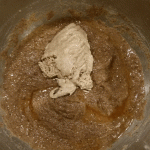 Combine the sponge with the scald, which will have loosened up and become very sweet, and mix well.
Combine the sponge with the scald, which will have loosened up and become very sweet, and mix well.
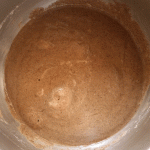 Cover and ferment at room temperature until the scald-sponge has expanded to at least 1½ times its original volume and its surface shows bubbles, 4-6 hours.
Cover and ferment at room temperature until the scald-sponge has expanded to at least 1½ times its original volume and its surface shows bubbles, 4-6 hours.
Final Dough (Day 2, Afternoon):
| Ingredient |
Grams |
Ounces |
||
| Scald-sponge |
1,179 |
41.60 |
||
| Whole rye flour |
640 |
22.55 |
||
| Salt |
10 |
0.35 |
||
| Sugar |
43 |
1.50 |
||
| Vegetable shortening for pan |
As |
needed | ||
Transfer the sponge into the bowl of a mixer, add the dough ingredients and use the dough hook at low (KA2) speed to mix until the dough has come together into a firm, slightly sticky mass, 8-10 minutes.
Cover and ferment at room temperature until visibly expanded, 30-40 minutes.
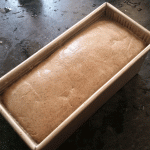 Turn the dough out onto a lightly dampened work surface and use wet hands to shape the dough into an oblong, then place it into a well-greased 9″x4″x4″/23x10x10 cm. Pullman loaf pan or 9″x5″x3″/23x13x8 cm standard loaf pan.
Turn the dough out onto a lightly dampened work surface and use wet hands to shape the dough into an oblong, then place it into a well-greased 9″x4″x4″/23x10x10 cm. Pullman loaf pan or 9″x5″x3″/23x13x8 cm standard loaf pan.
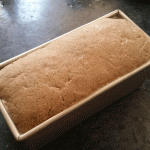 Smooth the dough with wet hands, cover and proof at room temperature until the dough rises above the rim of the pan and shows tiny broken bubbles that resemble pinpricks, 50-60 minutes.
Smooth the dough with wet hands, cover and proof at room temperature until the dough rises above the rim of the pan and shows tiny broken bubbles that resemble pinpricks, 50-60 minutes.
Preheat your oven to 460°F/230°C, with the baking surface in the middle. Brush the top of the loaf with water and bake 10 minutes. Lower the temperature to 375°F/190°C and continue baking until the loaf thumps when tapped with a finger and the internal temperature is at least 198°F/92°C, 55-60 minutes. Transfer to a rack and let cool thoroughly before slicing..
Baker’s Percentages:
| Ingredient |
g |
% |
| TOTAL FLOUR |
1,006 |
100.00% |
|
Whole rye flour |
640 |
63.62% |
|
Medium rye flour |
315 |
31.31% |
|
Malted rye |
51 |
5.07% |
| Water |
800 |
79.52% |
| Salt |
10 |
0.99% |
| Rye sour culture |
9 |
0.89% |
| Sugar |
43 |
4.27% |
| Caraway |
4 |
0.40% |
| TOTAL FORMULA |
1,872 |
186.08% |
| Flour prefermented |
315 |
31.31% |

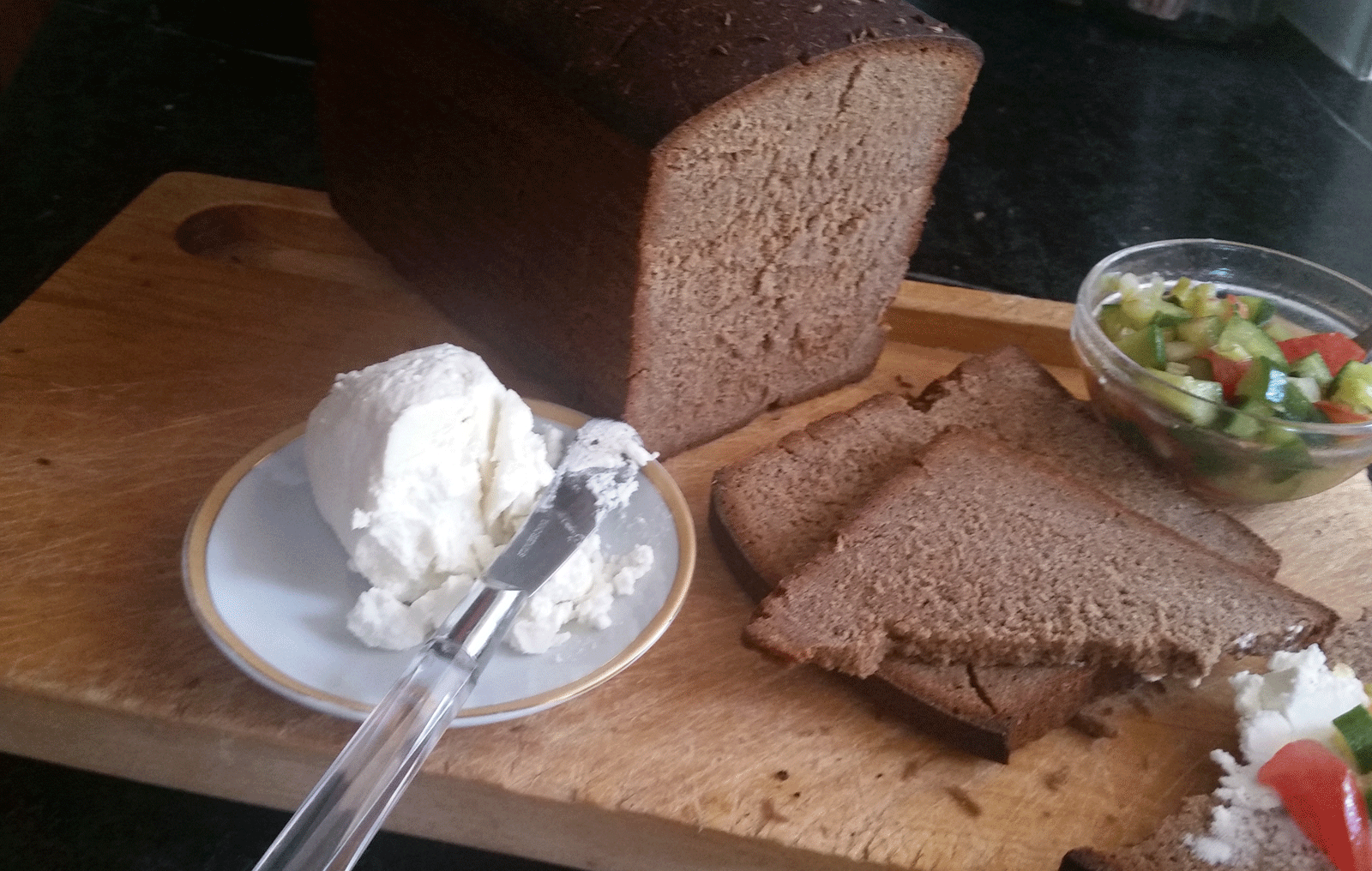
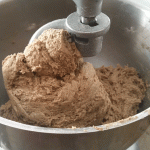
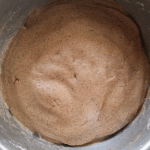
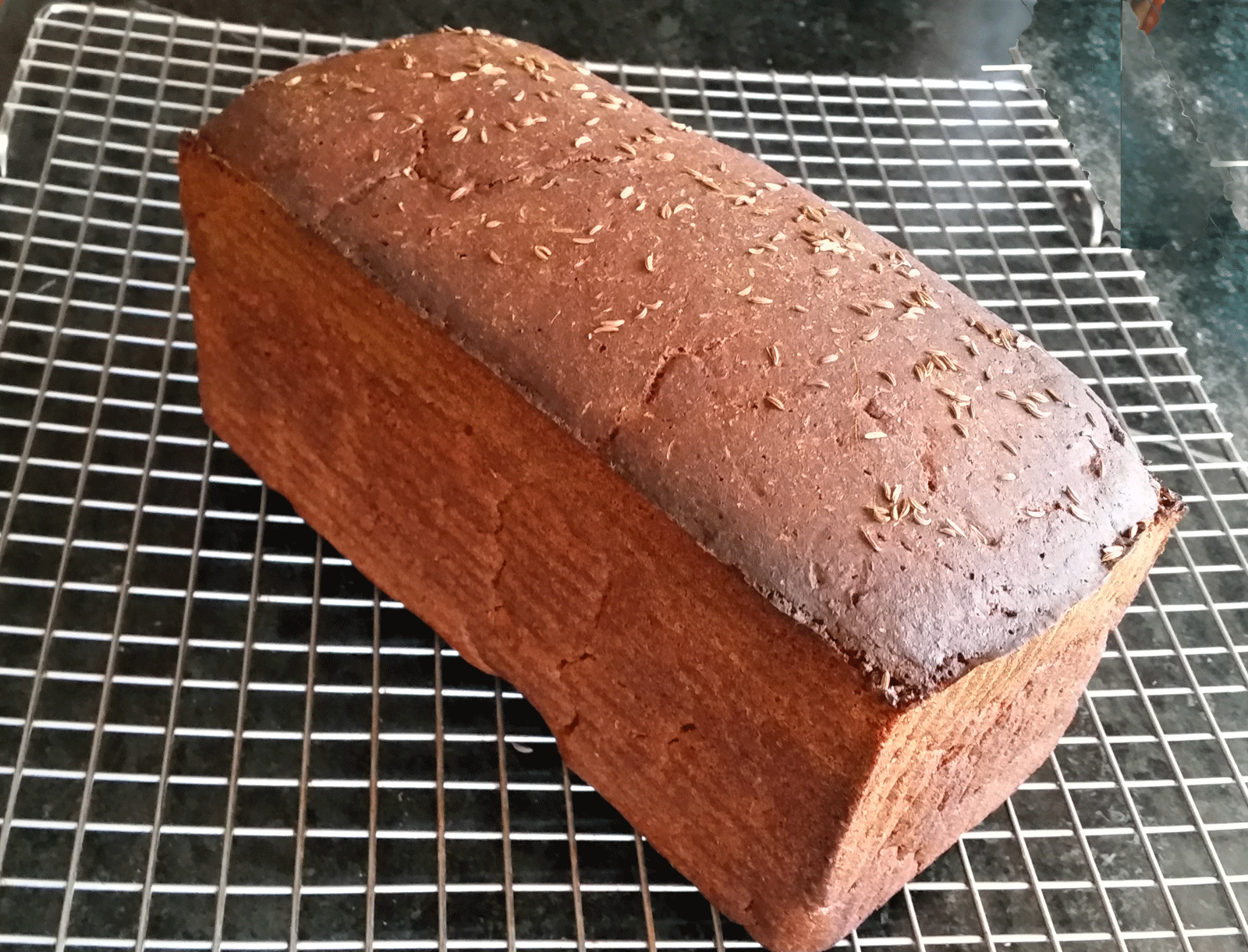
Monica Ioo
August 31, 2016Thank you very much for sharing!
Brownman
August 31, 2016Now that is one fine rye bread. Just the way we like it, Well done and Happy baking !
Brownman
irwin
November 12, 2016Very interesting to compare with GOST Borodinsky on pg 253 of your book.l
Stanley Ginsberg
November 17, 2016This one’s got a tighter, more cakelike crumb than the GOST, and the scalded caraway contributes a softer, more floral note than the citrusy coriander edge in the GOST.
josh
March 1, 2017where do i get malted rye?
Stanley Ginsberg
March 2, 2017You can buy it at homebrew supply outlets or through nybakers.com. NYB also will be carrying red (roasted) rye malt shortly. Keep an eye on the site.
PF
December 5, 2018I am seeing AB Mauri Low Diastatic Malt Powder on nybakers.com. Is that the red rye malt you are talking about? thank you
Stanley Ginsberg
December 15, 2018No, it’s not. AB Mauri malt is extracted from barley and is enzymatically active (diastatic). The red rye malt is non-diastatic and uses rye rather than barley.
Scot G
September 6, 2019Stanley — I buy the (non-roasted) malt from NY bakers. For Borodinski and other recipes — when toasting it for red rye malt, do you toast the kernels and then grind, or the other way around? In your rye baking cookbook, you mention (p. 42) that to toast rye malt in the oven, for red malt you toast at 450 degrees for 15 minutes — but when I tried toasting the malted rye kernels at that temp they were completely burned after <5 minutes.
Stanley Ginsberg
October 13, 2019I toast the whole grains and then grind. If your malted rye burns, as you note, just keep an eye on it and remove it from the oven when your kitchen fills with the sweet perfume of roasting rye malt.
Ramiro
October 30, 2018Sorry for the newbie question. but would be possible to attempt this bread without a mixer?
Stanley Ginsberg
October 31, 2018Of course! People were baking rye breads long before the invention of the mechanical mixer. In fact, hand-mixing will give you more familiarity with the feel and behavior of the dough than mechanical mixing ever could. Go for it!
Ramiro
October 31, 2018Thank you so much for the encouragement! Between you and a Russian friend I’m fully convinced about baking it as soon as I get some rye flour!
Gideon Itenberg
January 21, 20191. Rye bread Borodinskiy or not can be made as scalded, as well as not scalded. Scalded rye bread has better texture. It is nessasary to understand the purpose of scalding to be able to do it properly. The main idea of scalding is saccharification of rye malt. To do it properly it is nessasary after scalding rye malt and rye flour to keep it in steady temperature 145-149 F for 4-4.5 hours for proper saccharification. There is no other way to brake rye malt into sugar. Keeping it in room temperature non matter for how many hour will not do it.
2. Original Botodiskiy bread made with coriander and not with caraway or anise seeds. Coriander gives to Boridinskiy very distinguished taste.
3. Baking form is very important for proper rye dough rising. The best for borodinskiy would be: 6.3”x3.15” on top, 5.5”x2.36” on bottom and 3” deep. As it can be seen the form is much narrower on the bottom and deep. It is form specifically designed with Borodinskiy bread in mind. Of course you cannot find it in US. The available in US bread baking forms are lacking concederation for nature of low gluten content dough. In Russia this is a long standing tradition and of course all kinds of forms designed for different kinds of doughs in mind. I would consider Russian bread baking forms to be the best in the world.
Gideon Itenberg
January 22, 2019Btw, Auerman is not the only source of Russian breads recipes. There is more solid and comprehensive, in my opinion edition from the same period by name: “ 350 sortov Khlebo-boolochnikh eezdeliy” – “350 kinds of bread products” recipes and instructions.
Catarina
July 27, 2019Is it better to not use any malt at all than to use diastic malt?
I waited more than 8 hours for the scald-sponge because I didn’t see a significant rise (but it did felt light and spongy). The other two fermentations I didn’t see any rise at all so I baked a (delicious) brick.
joan
October 17, 2019I started this bread yesterday using abruzzi rye. The scald was always thicker than pudding texture. The house became surprisingly cold overnight (65F). It took seven hours for the combined scald-sponge to develop. I may have been deluding myself about bubbles. When I added the whole grain abruzzi flour it became apparent that nothing I could do would get all the flour absorbed so I added another 100 grams of water. My thoughts returned to memories of my German grandmother working dough with her fists. It took a great deal of strength to incorporate the additional flour by hand. I expect to spend a late night babysitting the dough. At this moment, I have my doubts about a good outcome.
t
June 24, 2020I was wondering about your bread pan–what brand/ type is it and where did you buy it? The shape of the finished loaf looks very different than what you usually get with a standard 9X5 loaf pan…
Stanley Ginsberg
July 14, 2020I use Pullman pans that I bought online from webstaurantstore.com.
Pingback: Wholegrain Rye Borodinsky Sourdough Bread: Ancestral Cook-Up September 2020 – Ancestral Kitchen